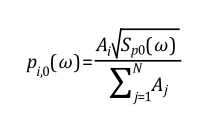-
-
November 19, 2024 at 9:40 am
z.aniretaj
SubscriberHello!
I am trying to understand how the Reference PSD and Number of Divisions on Reference Sphere settings in DSF influence the amplitude of the incident waves. Based on the formula below, I understand that the amplitude depends on both the Reference PSD and the area of each segment on the reference sphere:
From the solver output and settings, I understand that Number of Divisions on Reference Sphere represents the number of parallel divisions on the sphere. My questions are as follows:
- Does this parameter only divide the sphere into parallel rings (horizontal slices), or are there additional subdivisions to form segments (squares or rectangles)?
- If there are additional subdivisions, how exactly are they defined geometrically?
Ultimately, I need to know the exact area of each segment because it directly affects the amplitude calculation. Knowing the segment area will allow me to adjust the Reference PSD to achieve a specific amplitude (for example, 1 Pa).
Correct me if I'm wrong in my reasoning. Maybe I misunderstood something.I would appreciate any clarification or details about how the sphere is divided and how to interpret these settings.
Thank you!
-
November 19, 2024 at 10:08 am
Erik Kostson
Ansys EmployeeHi
I cannot provide detailed answers, but
Normally we look at TL of plates when using that so the diffuse and transmitted energy is a ratio so does not really matter (incoming diffuse energy since it isa ratio), as TL is Energy/Power_diffuse_in/Energy/Power_transmitted .
See an example (APDL help manual) here on what we mean:Acoustic Analysis Guide (APDL) . 13.15. Example: Structural Panel Subject to Excitation From a Diffuse Sound Field
This example problem demonstrates the use of the FLUID220 element to predict the transmission loss of a structural panel under excitation from a diffuse sound field.
All the best
Erik
-
November 19, 2024 at 10:26 am
z.aniretaj
SubscriberHi Erik
Thank you for your response!
- Is DSF used exclusively for evaluating Transmission Loss (TL)?
- What if I want to calculate the response of a body placed in a reverberation chamber? From what I understand, a diffuse sound field is created in such a chamber, correct? I would like to set the conditions to see how the body vibrates, and then compare those results with experimental data.
- Does this mean I’m misunderstanding the kinds of problems where DSF can be applied?
Thank you in advance for your clarification!
-
-
November 19, 2024 at 10:59 am
Erik Kostson
Ansys EmployeeHi
No worries.
Can not say 100 % but that is the application we have an example on and that I have seen so far.
Not sure on what you are trying to do - never seen it used like this.Perhaps someone else (forum member) has and can advice.
All the best
Erik-
November 20, 2024 at 9:30 am
z.aniretaj
SubscriberSorry, I have one more question. So DSF is applied on a surface. Is there a way to see value of the pressure that is generated on this surface in results section?
-
-
- You must be logged in to reply to this topic.



-
3467
-
1057
-
1051
-
929
-
896

© 2025 Copyright ANSYS, Inc. All rights reserved.







